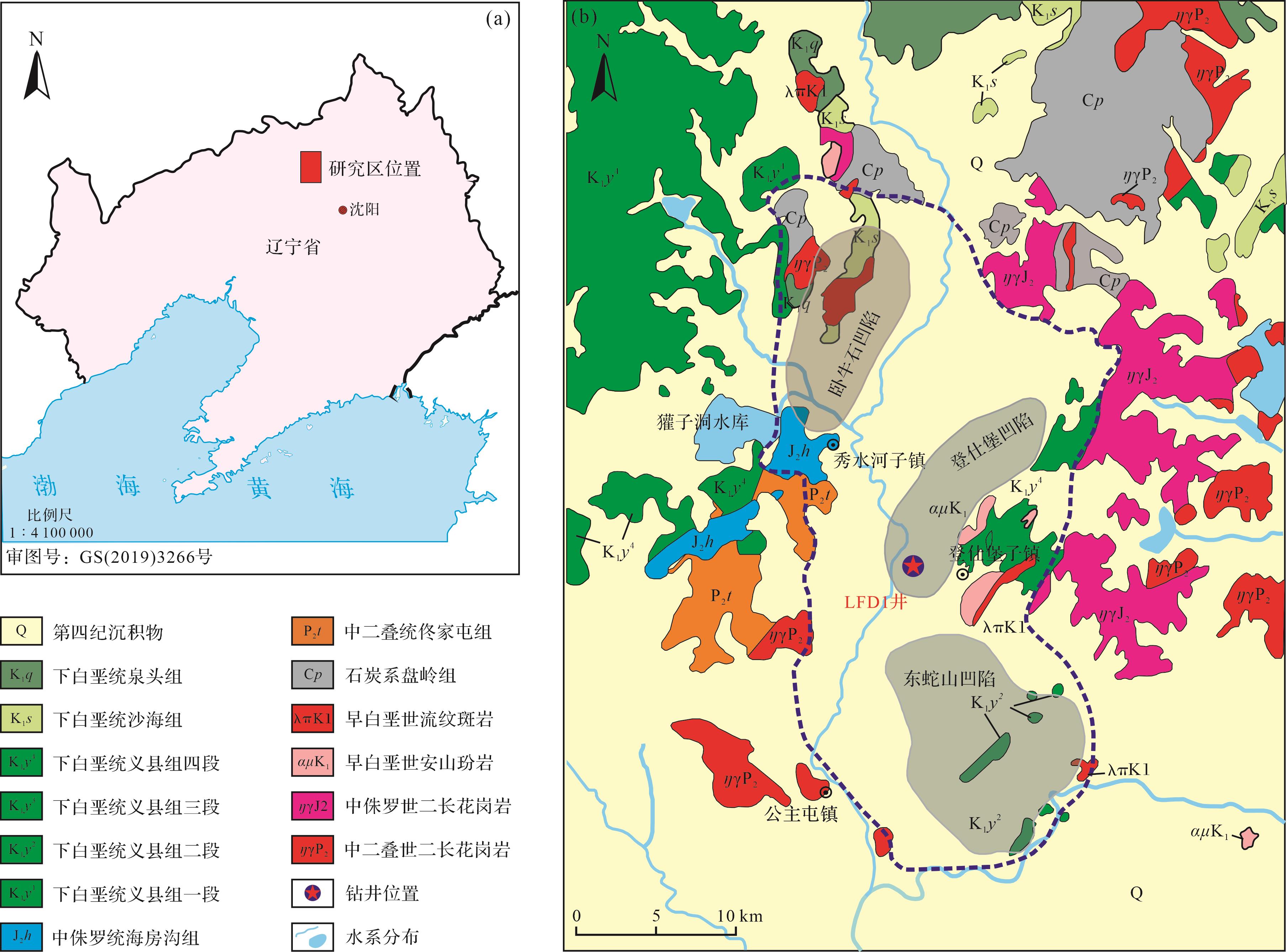-
辽宁北部的秀水盆地是近年来松辽盆地外围油气勘探中新勘测的地区,其油气勘探和研究程度都相对较低。自2015年以来,中国地质调查局沈阳地质调查中心在辽宁北部秀水盆地以油气勘探为目的,相继开展了地表地质、物探、钻探等油气地质调查工作,发现秀水盆地早白垩世地层具有良好的油气前景[1⁃3]。有机质类型、丰度和成熟度的初步研究,揭示秀水盆地义县组上部发育优质烃源岩[4⁃5]。
秀水盆地早前的研究主要集中在地球物理、构造、岩相年代和古生物学方向[2⁃3,6⁃8],近年来随着勘探井的实施,相关的地球化学研究也有所开展[4⁃5,9]。如李文博等[5]通过对秀水盆地义县组主、微量元素和稀土元素的研究,发现义县组沉积时期为淡水、深水还原环境;而李晓海等[9]根据生物标志物的分析,发现义县组烃源岩主要形成于半咸水弱还原环境。秀水盆地义县组沉积时期的沉积环境到底如何?其高有机质沉积的富集机制怎样?目前仍缺乏系统的研究。因此,拟通过对秀水盆地义县组二段、三段泥岩、泥质粉砂岩沉积有机碳含量及其稳定碳同位素和生物标志化合物的分析,探讨义县组二段、三段沉积时期有机质的母质来源和沉积环境演化,进而解析秀水盆地义县组沉积有机质的富集机制。
-
秀水盆地位于辽宁北部,面积约710 km2,是发育在海西褶皱基底和前寒武基底之上的小型中生代断陷盆地,呈北东向条带状展布[2,7](图1)。在秀水盆地广泛发育一套分布广泛、沉积厚度较大的陆相沉积岩,通过岩性组合、孢粉对比[7]和碎屑锆石年代学研究[8],确定该套陆相沉积岩形成于早白垩世。盆地下白垩统主要发育三个地层组,分别为义县组、九佛堂组和沙海组地层,上白垩统地层缺失。根据沉积地层、构造和盆地基地等特征的研究,前人将早白垩世秀水盆地发育过程划分为四个阶段[2,6]:(1)盆地拉张形成阶段,形成大规模中性和基性火山岩;(2)湖盆沉降稳定沉积阶段,形成义县组二段和三段大段的沉积岩建造;(3)湖盆萎缩火山活动阶段,义县组四段时期大规模岩浆岩侵入,同时形成酸性火山岩地层;(4)湖盆消减抬升阶段,九佛堂组沉积之后湖盆进一步萎缩,秀水盆地出现差异性隆升,部分地区接受剥蚀,部分地区接受沉积。

图 1 (a)研究区位置;(b)秀水盆地地质概况及LFD1井钻孔位置(据文献[6]修改)
研究样品来自秀水盆地登仕堡子凹陷的LFD1井。LFD1井位于獾子洞水库东南,登仕堡子镇西侧(图1b),该井义县组沉积地层厚度为280 m[9],包括完整的义县组一段到四段地层。研究样品来自LFD1井义县组二段和三段中185~1 170 m的沉积岩,主要为暗色泥岩、粉砂质泥岩和泥质粉砂岩,共87块。根据沉积岩性组合特征,将所研究的井段划分为三个阶段:阶段Ⅰ(900~1 170 m)、阶段Ⅱ(560~900 m)及阶段Ⅲ(185~560 m)。其中阶段Ⅰ为义县组二段沉积—火山碎屑岩段,厚度较大的火山碎屑岩中发育间断的小规模碎屑沉积岩,岩性为粗颗粒的砂岩和细颗粒的灰黑色粉砂岩互层;阶段Ⅱ最下部为火山岩,接着为义县组三段早期沉积地层,下部为灰白色砂岩和灰黑色泥质粉砂岩互层,向上逐渐过渡到黑色泥质粉砂岩和粉砂质泥岩,在较厚的黑色粉砂质泥岩之上又发育粗颗粒砂岩到细颗粒粉砂质泥岩的沉积旋回;阶段Ⅱ和阶段Ⅲ沉积岩之间有闪长玢岩侵入,致使地层缺失。阶段Ⅲ为义县组三段晚期沉积地层,底部为灰色细砂岩和灰黑色粉砂岩互层,向上递变为灰黑色细砂岩、灰黑色泥质粉砂岩和粉砂质泥岩互层(图2)。
辽西地区义县组测年数据显示其沉积时代为120~125 Ma[10⁃12],U-Pb锆石测年显示秀水盆地义县组沉积上限年龄约为121 Ma[8],可以看出秀水盆地义县组的年龄与辽西地区义县组的沉积年龄基本一致。因此,本文研究的LFD1井义县组二、三段样品的地层年代为早白垩世巴雷赫姆期末期—阿普第期早期。
-
岩石样品表面用纯净水冲洗干净,在50 ℃下烘干后将样品粉碎至80目。称取适量样品加过量稀盐酸(浓度约为4 mol/L)浸泡,常温条件下反应24 h,以去除碳酸盐,再用去离子水清洗样品至中性,之后冷冻干燥、磨匀样品待用。去除碳酸盐后的样品分别在Vario EL cube元素分析仪和CE Flash EA1112-Finnigan Delta plus XL稳定同位素比质谱仪上进行有机碳含量(OC)和稳定碳同位素(δ13Corg)测试,所有样品均测试两次,最终结果取平均值。总有机碳(TOC)含量结果表示为wt.%,误差小于5%。稳定碳同位素(δ13Corg)结果以相对于PDB标准的千分比(‰)表示,测试误差<±0.3‰。
-
称取适量样品加入二氯甲烷/甲醇(9∶1,V/V)混合溶剂进行索氏抽提(72 h),为除去样品中可能存在的硫元素,需要在抽提底瓶中加入适量铜片。抽提物经浓缩和溶剂转换后进行沥青质沉淀,除去沥青质的可溶有机质用硅胶和氧化铝层析柱进行族组分分离,分别用正己烷、正己烷/二氯甲烷(1∶1,V/V)和二氯甲烷/甲醇(3∶1,V/V)混合溶剂淋洗层析柱,依次得到饱和烃、芳烃和极性组分。利用气相色谱(GC)及色谱/质谱(GC/MS),对饱和烃进行定性和定量分析。
-
使用Agilent 7890B气相色谱仪,FID检测器,对饱和烃组分中烷烃进行定量分析。色谱仪进样口温度为290 ℃,检测器温度为290 ℃。色谱柱为HP⁃1MS硅胶熔融毛细管柱(60 m长×0.25 mm内径×0.25 μm涂层)。采用无分流进样。升温程序:初始温度70 ℃保留2 min,以10 ℃/min升至120 ℃,再以5 ℃/min升至310 ℃,保留40 min。载气为氮气,流速1.2 mL/min。
-
使用气相色谱质谱联用(GC/MS)仪在饱和烃组分中检测甾烷和藿烷类化合物。分析仪器为Agilent 8890A-Platform II气相色谱质谱仪,色谱柱为HP-1MS硅胶熔融毛细管柱(60 m长×0.32 mm内径×0.25 μm涂层)。使用全扫描和选择离子扫描(SIM)模式,全扫描m/z范围为50~600,SIM模式选择接收m/z分别为217,191的离子;采用无分流进样,进样口温度290 ℃,离子源的温度250 ℃,电子轰击强度为70 eV。升温程序:色谱柱箱初始温度70 ℃,恒温1 min然后以10 ℃/min的速率升至120 ℃,再以3 ℃/min的速率上升至310 ℃,保留25 min。载气为氦气,流速为1.2 mL/min。
-
LFD1井义县组二段、三段TOC介于0.01%~4.78%(图2)。TOC含量与岩性有一定的对应关系:暗色泥岩层位中TOC相对较高,灰色泥岩、粉砂岩层位TOC偏低,砂岩、砾岩层位TOC最低。
LFD1井义县组二段、三段δ13Corg介于-30.9‰~-24.6‰(图2)。义县组二段δ13Corg偏轻(-30.9‰~-27.2‰),而三段样品δ13Corg相对偏重(-29.6‰~-24.6‰),三段底部往上呈逐步偏重的变化趋势(图2)。
-
从LFD1井义县组二、三段不同深度样品的饱和烃气相色谱图(图3)可以看出,正构烷烃碳数的分布范围为C12~C35,呈单峰分布,大部分样品主峰碳都为中碳数(n-C21~26)和低碳数(≤n-C20),少数样品主峰碳为n-C27或者n-C29。所有样品中都检测到了姥鲛烷、植烷(图3),Pr/Ph比值在不同层位存在明显变化(图4)。
阶段Ⅰ正构烷烃总含量为6.76~154.49 μg/g干重,其中∑n-C14~20占20.3%~65.1%,∑n-C21~26占28.1%~42.4%,∑n-C27~35占6.8%~37.3%。碳优势指数CPI25~33介于1.03~1.23,变化范围小。Pr/Ph值介于0.79~1.36(图4)。
阶段Ⅱ正构烷烃总含量为0.62~849.67 μg/g干重,其中∑n-C14~20占5.3%~93.2%,∑n-C21~26占4.7%~53.5%,∑n-C27~35占0.1%~48.5%。此阶段CPI25~33为0.97~1.47,Pr/Ph值为0.22~1.49。阶段Ⅱ正构烷烃相对百分含量随深度存在显著的变化,因此将阶段Ⅱ进一步划分为Ⅱ1(626~650 m)和Ⅱ2(560~624 m)(图4)。阶段Ⅱ1长链正构烷烃(n⁃C27~35)的百分含量为12.1%~48.5%,为整个沉积阶段的峰值,同时Pr/Ph表现为低值;阶段Ⅱ2长链正构烷烃含量明显降低,短链正构烷烃(n⁃C14~20)和中链正构烷烃(n⁃C21~26)占据主导(图4)。
阶段Ⅲ正构烷烃总含量为0.33~414.89 μg/g干重,其中∑n-C14~20占19.2%~90.9%,∑n-C21~25占5.9%~47.3%,∑n-C27~35占3.1%~50.1%。此阶段中链正构烷烃的百分比相对较高,且稳定。碳优势指数CPI25~33介于0.91~1.87,波动明显。Pr/Ph值介于0.28~1.19(图4)。
-
LFD1井义县组二、三段样品中都检测出了C27~29规则甾烷(图5),所有样品都表现为C29和C27规则甾烷相对含量较高,C28规则甾烷相对含量较低,样品中C27~29规则甾烷呈V型或(反)L型分布。样品中C29ααα规则甾烷20S/(20S+20R)支链异构化参数介于0.20~0.57,主要集中在0.4~0.6,C29规则甾烷的环异构化参数ββ/(αα+ββ)比值介于0.20~0.60,同样也普遍大于0.4。样品中也检测到了丰富的C27重排甾烷(DiaC27,图5)。C27和C29规则甾烷相对丰度在LFD1井义县组二段、三段中表现出明显的变化特征:从下往上,C27甾烷相对含量呈上升趋势,C29规则甾烷则表现为下降趋势(图6)。
阶段ⅠC29规则甾烷的相对含量较高,C27和C28规则甾烷相对较低,C29/C27介于1.01~4.11,普遍大于2;C27重排甾烷/C27规则甾烷(DiaC27/C27)介于0.10~0.60;甾烷/藿烷比值较低,介于0.07~0.38(图6)。
阶段Ⅱ1C29规则甾烷的相对含量略有下降但还是处于高值,C29/C27介于0.86~3.28;DiaC27/C27表现为极低值,介于0.05~0.49(均值为0.09);甾烷/藿烷比值介于0.26~0.46,略高于阶段Ⅰ。阶段II2各类甾烷化合物的相对含量出现波动性变化,C29规则甾烷明显下降,C27规则甾烷相对含量上升,C29/C27介于0.52~2.38;DiaC27/C27升高,介于0.10~0.56;甾烷/藿烷比值呈高值,介于0.30~1.66(图6)。阶段Ⅲ甾烷的C29/C27介于0.65~3.32,该比值在192~248 m有所上升;DiaC27/C27介于0.06~0.47;甾烷/藿烷比值介于0.06~1.24(图6)。
-
LFD1井检测到碳数为C27~C35的藿烷类化合物,普遍表现为C30αβ藿烷丰度最高,C28藿烷缺失(图7)。阶段Ⅰ和阶段Ⅱ1藿烷丰度高,可以检测到明显的C33~C35升藿烷;但在阶段Ⅱ2中藿烷类化合物的丰度很低,没有检测出碳数大于C33的升藿烷;在阶段Ⅲ样品中可以检测到丰度较低的碳数大于C33的升藿烷。除了常见藿烷类化合物,在样品中也普遍检测到含量较低的伽马蜡烷(图7),计算结果显示伽马蜡烷指数(伽马蜡烷/C30αβ藿烷)介于0.03~0.26,处于较低值(图6)。
-
有机质稳定碳同位素组成、正构烷烃和甾烷的分子组成特征都可以用来指示有机质来源。不同来源的有机质,其稳定碳同位素(δ13Corg)组成不同,白垩纪陆生植物化石的δ13Corg值介于-26.0‰~-21.8‰[13⁃16]、陆源有机质的δ13Corg值介于-27.8‰~-21.2‰[15,17⁃20]、典型海洋有机质的δ13Corg值介于-28.3‰~-21.5‰[20⁃21]、湖泊有机质的δ13Corg值介于-32.2‰~-18.5‰[22⁃24]。因湖泊有机质的来源复杂且多样,其δ13Corg值范围较大,但总体上湖泊内源有机质的碳同位素组成要轻于陆源有机质的组成[19]。LFD1井样品中δ13Corg值介于-30.9‰~-24.6‰,整体上小于典型陆源有机质的δ13Corg值,表明秀水盆地义县组二、三段有机质主要来源于湖泊内源。姚玉来等[4]指出秀水盆地南部秀水D1井中义县组岩石的有机质类为Ⅱ1型和Ⅱ2型,同样指示了湖泊沉积物中的有机质主要来源于湖泊内源。
正构烷烃中的短链(n⁃C14~20)正构烷烃主要来源于低等藻类和细菌,中链(n⁃C21~26)正构烷烃主要来源于大型的水生植物和苔藓类[25⁃26],且具有奇碳优势;而长链正构烷烃(n⁃C27~35)主要来源于陆地高等植物,且表现出强烈的奇碳优势[27]。通常认为C27甾烷来源于藻类而C29甾烷主要来源于高等植物[28],但是目前有许多研究表明C29甾烷也可以来源于绿藻[29]、硅藻及红藻等水生藻类[30]。
高的有机质成熟度会影响生物标志物的分子组成,秀水盆地义县组样品中CPI25~33值大部分接近1(图4),C29ααα规则甾烷20S/(20S+20R)和C29规则甾烷ββ/(αα+ββ)都集中在0.4~0.6,显示出秀水盆地义县组样品基本进入了成熟阶段。这与姚玉来等[4]所测得的义县组镜质体反射率(Ro,平均值0.87%)指示的成熟度一致。因此认为成熟度不是影响生物标志物变化的主要因素。
如图4和6所示,LFD1井样品正构烷烃和甾烷在剖面上都呈现出明显的变化特征。
阶段Ⅰ(900~1 170 m):δ13Corg值介于-31.0‰~-27.2‰(图2),明显小于白垩纪陆源有机质碳同位素值(-27.8‰~-21.2‰)和陆地植物的碳同位素值(-26.0‰~-21.8‰);同时短链和中链正构烷烃百分含量高,平均值分别为44.4%和35.3%,长链正构烷烃百分含量较低,平均值为20.3%(图4),秀水盆地义县组二段沉积有机质主要来源于湖泊内源。尽管该阶段长链正构烷烃的百分含量平均为20.3%,且C29规则甾烷含量高(图6),但CPI25~33值接近1(1.03~1.23)。Peter et al.[31]指出当CPI值接近1时,可能代表了有机质来源浮游生物和底栖细菌,某些细菌、藻类和部分水生植物能够合成长链正构烷烃,且这些来源于细菌和藻类的长链正构烷烃不具有奇偶优势,例如已经发现非海相藻类(Botryococcus braunii湖泊布朗丛粒藻)可以合成n⁃C27~31的正构烷烃[30],C29规则甾烷也可以来源于水生藻类[29⁃30]。目前还不能肯定这些长链正构烷烃和C29规则甾烷是否来源于细菌或藻类,但是结果显示此阶段陆源有机质的贡献比例较低。
藿烷化合物主要来源于细菌[32⁃33],该阶段中藿烷的绝对含量介于0.07~9.81 μg/g,但是甾烷/藿烷比值却是沉积阶段中最低的(0.07~0.38,图6),表明阶段Ⅰ湖泊中细菌活动比较强烈。因此,总体上秀水盆地义县组二段时期湖泊内藻类和细菌繁盛,是沉积有机质的主要贡献者。
阶段Ⅱ1(626~650 m):δ13Corg值介于-28.8‰~-26.1‰(图2),略小于白垩纪陆源有机质碳同位素值。该阶段短链正构烷烃的百分比含量介于5.3%~61.8%,平均为33.1%;中链正构烷烃百分比含量介于20.7%~46.5%,平均为36.6%;长链正构烷烃百分比含量介于12.1%~48.4%,平均为30.3%,与阶段Ⅰ相比明显升高(图4),指示陆源高等植物的输入比例升高。同时甾烷的C29/C27介于0.85~3.27,平均值高达2.18(图6),也表明此阶段陆生高等植物对有机质的贡献比例明显上升。
此阶段藿烷绝对含量达到峰值,变化范围为0.03~42.5 μg/g(图6),表明此阶段细菌对有机质的贡献比例增加。甾烷/藿烷比值平均为0.33,处于低值阶段(图6)。海洋沉积有机质因藻类输入占优势,其甾烷/藿烷比值普遍较高,而陆源沉积有机质中甾烷/藿烷比值一般较低[34⁃36]。较低的甾烷/藿烷比值也表明了本阶段陆源有机质的贡献比例升高。
阶段Ⅱ2(567~624 m):δ13Corg值出现较大的波动,变化范围为-29.6‰~-24.6‰(图2)。短链正构烷烃的百分比含量介于29.5%~93.2%,平均为61.8%,占据了绝对优势;中链正构烷烃百分比含量介于4.7%~53.4%,平均为28.0%;长链正构烷烃百分比含量介于0.1%~32.7%,平均为10.2%(图4),反映此阶段的沉积有机质来源主要为湖泊内源藻类。甾烷的C29/C27比值明显降低(图6),也间接指示了湖泊内藻类的繁盛。同时藿烷含量明显降低(0.01~2.73 μg/g,图6),甾烷/藿烷比值显著升高,反映了该阶段沉积有机质中细菌的贡献比例急剧减少。因此阶段Ⅱ2中湖泊沉积有机质主要来源于湖泊内源藻类,陆源高等植物和细菌的贡献比例都明显降低。
阶段Ⅲ(300~185 m):δ13Corg值总体偏重(-28.4‰~
-24.8‰,图2)。其短链正构烷烃百分比含量介于19.2%~90.9%,平均为57.3%;中链正构烷烃百分比含量介于5.9%~47.3%,平均为29.8%;长链正构烷烃百分比含量介于3.1%~50.1%,平均为12.9%(图4)。此阶段以短链和中链正构烷烃为主,其中短链正构烷烃的百分比含量在250~265.8 m和191~185 m出现了两次峰值,平均值分别为69.3%和79.9%,此时的甾烷/藿烷比值也出现高值,而甾烷C29/C27 <1,指示该阶段湖泊可能出现了两期大规模的藻类勃发。在192~248 m处藿烷的含量升高,最高可达32.3 μg/g(图6),表明此时细菌的贡献比例升高。阶段Ⅲ沉积有机质主要来源于湖泊内源的藻类和水生植物,出现了两次藻类的勃发,并记录了陆生高等植物输入信号和强烈细菌活动。
-
伽马蜡烷是一种来源于四膜虫醇的C30带环烷烃。生活于化跃面、循环水体和非循环水体界面及其底部厌氧环境中的纤毛虫是伽马蜡烷的重要来源。由于纤毛虫生活在分层水体中,故伽马蜡烷的存在可以作为水体分层的标志[37⁃38]。LFD1井义县组二、三段样品中检测出低含量的伽马蜡烷(图7),伽马蜡烷指数也较低(0.03~0.27,平均为0.1,图6),表明秀水盆地在义县组沉积时期存在微弱的水体分层现象。Ding et al.[39]认为小规模的湖盆裂谷盆地以范围小、水体浅、近源堆积和高沉积速率为特征,难以形成稳定的水体分层。秀水盆地为小型断陷盆地,且较高的沉积速率使其不存在长期稳定的水体分层。
水体的氧化还原条件是控制有机质保存和降解的重要条件,Pr/Ph值可以用来指示沉积环境的氧化还原状态[40]。一般情况下,Pr/Ph值小于0.8代表强还原环境,在0.8~1.0范围指示贫氧弱还原的沉积条件,当Pr/Ph值大于1.0时指示偏氧化环境。尽管许多研究中认为Pr/Ph值会受成熟度的影响,但是本次研究中样品的成熟度基本一致,可以排除成熟度对该比值的影响。甾醇在早期成岩阶段形成甾烯,甾烯在黏土矿物酸性催化作用形成重排甾烷[41],重排甾烷的形成除了与矿物组成有关以外,也和氧化还原条件有关,强还原条件不利于形成重排甾烷,偏氧化的条件有利于重排甾烷的生成[42⁃43],因此,重排甾烷/规则甾烷的比值也可以间接指示氧化还原条件。前人认为秀水盆地义县组形成时处于还原环境[5,9],本研究通过对比植烷、姥鲛烷以及重排甾烷的剖面变化(图4、6),发现义县组二段和三段沉积环境在还原条件和弱氧化条件之间波动变化,底层水体并未长期处于缺氧状态。不同阶段的水体环境变化如下。
阶段Ⅰ:Pr/Ph值介于0.79~1.36,大部分样品的Pr/Ph值接近于1(图4),指示该阶段为弱还原—弱氧化的贫氧环境。该阶段伽马蜡烷指数较低(0.04~0.24,图6),说明水体没有出现稳定的分层,不利于形成强还原环境。同时重排甾烷/规则甾烷(DiaC27/C27)在该阶段的大部分比值也比较低(图6),间接指示了贫氧环境。但DiaC27/C27值在989.4 m、991 m、1 168 m及1 170 m 附近出现了相对高值(图6),其Pr/Ph值也升高(图4),表明在这些层段,湖泊水体的氧化性增强。这些层位为粉砂质泥岩,含有凝灰质碎屑[2],上覆凝灰质火山岩,推测由于火山活动喷发的物质进入湖泊水体,使得水体环境发生了改变。
阶段Ⅱ1:Pr/Ph值介于0.22~0.76,平均为0.56,整体为低值阶段(图4),指示了强还原的缺氧沉积环境。DiaC27/C27介于0.05~0.49,平均为0.12(图6),极低的DiaC27/C27也指示了强还原条件。进入Ⅱ2阶段后,Pr/Ph值表现为先上升再下降(图4),反映沉积环境由还原逐渐向弱氧化状态转变,再变为还原状态的过程。DiaC27/C27值在Ⅱ2阶段中介于0.10~0.55,平均为0.36,明显高于Ⅱ1阶段(图6),反映水体环境氧化性相对增强。
阶段Ⅲ:Pr/Ph主要集中在0.8~1.2,指示水体弱氧化—弱还原状态,在浅部样品中(188 m)出现低值(图4)。DiaC27/C27值在早期较高,晚期降低(图6),间接指示弱氧化—弱还原状态。两个比值都指示在沉积后期水体的还原性增强。
-
湖相富有机质沉积的发育受控于三个因素:湖泊初级生产力、保存条件和沉积速率[44],基于此,本文分析了秀水盆地义县组二、三段富有机质沉积形成机制,并绘制了湖泊水体演化阶段示意图(图8)。
阶段Ⅰ:其TOC含量介于0.18%~3.27%(图2),偏轻的有机质稳定碳同位素组成、丰富的短链和中链正构烷烃以及含量较高的藿烷类化合物,反映其有机质主要来源于湖泊内源藻类、细菌和水生植物。该段地层中发现了大量的凝灰质碎屑,指示沉积时期受到了火山活动的影响。火山活动释放大量火山灰进入湖泊水体环境,为湖泊带来大量的Fe、P、N、Si等营养元素,促进了湖泊初级生产力的繁盛[45⁃46]。同时火山活动释放出大量的CO2,湖泊生物可利用碳源增加,形成了贫13C的沉积记录。此时沉积环境为弱还原—弱氧化状态,此阶段的水体条件虽然不是十分有利于有机质保存,但在火山作用下,繁盛的湖泊生物提供的大量有机质能够形成富有质沉积(图8)。
阶段Ⅱ1:TOC呈现出上升趋势(图2),偏重的有机质稳定碳同位素组成和高百分比的长链正构烷烃,反映此阶段陆源高等植物的输入比例升高,水体环境为较强的还原缺氧环境,有利于有机质的保存。白垩纪时期陆源有机质稳定碳同位素相对偏重[14⁃16],因此该阶段表现为有机质δ13Corg值偏高。
阶段Ⅱ2:TOC含量整体较高(图2),繁盛的藻类和水生植物是沉积有机质的主要来源,沉积环境从缺氧还原逐步变为弱氧化状态,湖泊水体变浅,来源于水生植物的中链正构烷烃含量逐渐上升,湖泊水体向弱氧化状态转变,有机质的降解增强,使得沉积有机质δ13Corg值逐渐升高;之后水体变深,湖泊内源藻类又占据主导地位,沉积有机质δ13Corg值降低。在该阶段末期TOC含量和正构烷烃含量都明显下降,尽管沉积环境仍然处于弱还原状态,但由于有机质的输入减少,且降解作用相对增强,使得沉积有机质的δ13Corg值升高。
阶段Ⅲ:阶段Ⅱ中岩性以粉砂岩和粉砂质泥岩为主,进入阶段Ⅲ后岩性主要为细砂岩,反映了相对较快沉积速率,较快的沉积速率可能使得有机质被稀释,样品的TOC含量(0.07%~2.58%)整体低于阶段Ⅱ。阶段Ⅲ的底部和顶部都检测出了含量相对较高的伽马蜡烷,推测当时存在水体分层,有利于有机质的保存,因此,阶段Ⅲ的底部和顶部都出现了TOC高值(图2)。甾烷和藿烷类化合物的数据表明,湖泊在此阶段出现了藻类的勃发,且存在强烈细菌改造活动。
-
(1) 秀水盆地LFD1井义县组二段和三段沉积岩有机质含量丰富,TOC介于0.01%~4.78%,并进入了成熟阶段,具有良好的油气勘探前景。
(2) 义县组沉积有机质主要来源于湖泊内源的细菌、藻类和水生植物,陆生植物的贡献较少。
(3) 义县组二段沉积环境处于弱氧化—弱还原条件,火山活动促进了初级生产力水平的提高,是该阶段有机质富集的关键;三段沉积早期,湖泊中藻类和水生植物繁盛,极高的初级生产力有利于形成有机质含量高的沉积建造,沉积环境在还原—弱氧化条件下变化影响了δ13Corg记录;三段沉积晚期,沉积速率加快,陆源碎屑物质输入的增加对有机质积累起到了稀释作用。
Mechanism of Organic Matter Enrichment of Lower Cretaceous Yixian Formation in the Xiushui Basin, Northern Liaoning Province: A case study of well LFD1
-
摘要: 目的 辽宁北部秀水盆地为中生代小型断陷盆地,发育沉积厚度巨大的下白垩统义县组地层,需要明确其有机质富集方式。 方法 通过对秀水盆地LFD1井义县组二段和三段沉积岩开展了有机质稳定碳同位素组成以及正构烷烃、甾烷和藿烷等生物标志化合物的有机地球化学研究。 结果与结论 秀水盆地LFD1井义县组二段和三段沉积岩有机质含量高,变化范围为0.01%~4.78%,且已经进入成熟阶段,具有良好的油气勘探前景;其有机质沉积演化划分为四个阶段:阶段Ⅰ,火山活动促进了生产力水平的提高,在弱还原—弱氧化的条件下形成了δ13Corg偏轻、有机质含量高的沉积记录;阶段Ⅱ1,δ13Corg偏重的陆生植物碎屑大量进入湖泊中,沉积环境处于强还原状态;阶段Ⅱ2,沉积环境在还原—弱氧化状态下变化,湖泊水体中藻类和水生植物繁盛,提供大量有机质促使形成了高TOC的沉积建造;阶段Ⅲ,沉积速率加快,对有机质富集起到了一定稀释作用,但该阶段的开始和结束出现了短暂的强还原沉积环境和水体分层,并在对应层位形成了有机质相对较高的沉积记录。Abstract: Objective The Xiushui Basin,located in northern Liaoning,is a small faulted basin formed in the Mesozoic,and developed the Lower Cretaceous Yixian Formation with large sedimentary thickness. It is of great importance to understand the mechanism of organic matter enrichment. Methods In this study,sediment samples were collected from well LFD1. Total organic carbon (TOC) content,stable carbon isotopic composition (δ13Corg) and the distribution of molecular markers (aliphatic hydrocarbons,steranes and hopanes) from members 2 and 3 of the Yixian Formation were analyzed. Results and Discussions The results show that the TOC ranged from 0.01% to 4.78%,and the organic matter was mature. The vertical variations of the bulk organic parameters (TOC and δ13Corg) and biomarker indices indicated that the profile could be divided into four stages. Stage I: The initial content was enhanced by volcanic activity that enabled the depostions of great amount of organic matter and low δ13Corg values. Stage II1: High δ13Corg values suggest increased input from land plants. The biomarker indices show a relatively anoxic environment at this stage. Stage II2: The sedimentary environment is anoxic-weakly oxic. Algae and aquatic plants flourished in the lake,and the abundant organic matter facilitated the deposition of organic-rich source sediments. Stage III: A more rapid sedimentation rate diluted the abundance of organic matter. However,water column was stratified and lake evolved into anoxic environment at the beginning and end of this stage,which favored high organic matter content deposition.
-
Key words:
- Yixian Formation /
- biomarkers /
- sedimentary environment /
- source of organic matter
-
图 1 (a)研究区位置;(b)秀水盆地地质概况及LFD1井钻孔位置(据文献[6]修改)
-
[1] 陈树旺,公繁浩,杨建国,等. 松辽盆地外围油气基础地质调查工程进展与未来工作方向[J]. 中国地质调查,2016,3(6):1-9. Chen Shuwang,Gong Fanhao,Yang Jianguo,et al. Progress and orientation of the project about fundamental geological survey on oil and gas resources in the periphery area of Songliao Basin[J]. Geological Survery of China,2016,3(6): 1-9. [2] 丁秋红,李晓海,李文博,等. 辽宁北部秀水盆地义县组地层划分的地球物理响应特征[J]. 地质与资源,2020,29(1):44-52,6. Ding Qiuhong,Li Xiaohai,Li Wenbo,et al. Geophysical response of the stratigraphic division of Yixian Formation in Xiushui Basin,northern Liaoning province[J]. Geology and Resources,2020,29(1): 44-52, 6 [3] 张鹏辉,张小博,袁永真,等. 辽河外围北部秀水盆地大地电磁测深研究[J]. 物探与化探,2019,43(5):986-996. Zhang Penghui,Zhang Xiaobo,Yuan Yongzhen,et al. A study of magnetotelluric sounding of Xiushui Basin in the northern periphery of Liaohe[J]. Geophysical and Geochemical Exploration,2019,43(5): 986-996. [4] 姚玉来,李晓海,司江福,等. 辽宁北部秀水盆地秀D1井烃源岩评价[J]. 地质与资源,2018,27(2):186-191. Yao Yulai,Li Xiaohai,Si Jiangfu,et al. Evaluation on the source rocks from X-D1 well in Xiushui Basin,northern Liaoning province[J]. Geology and Resources,2018,27(2): 186-191. [5] 李文博,李晓海,丁秋红,等. 辽宁北部秀水盆地白垩系义县组泥岩地球化学特征及地质意义[J]. 现代地质,2019,33(2):284-292. Li Wenbo,Li Xiaohai,Ding Qiuhong,et al. Geochemical characteristics of the Cretaceous Yixian Formation mudstones in Xiushui Basin of northern Liaoning and their geological significance[J]. Geoscience,2019,33(2): 284-292. [6] 丁秋红,陈树旺,李晓海,等. 辽宁省北部秀水盆地下白垩统地质特征及含油气前景[J]. 中国地质调查,2019,6(3):14-21. Ding Qiuhong,Chen Shuwang,Li Xiaohai,et al. Geological characteristics and oil-bearing prospect of Lower Cretaceous in Xiushui Basin of northern Liaoning province[J]. Geological Survey of China,2019,6(3): 14-21. [7] 丁秋红,陈树旺,李晓海,等. 辽宁北部秀水盆地秀D1井孢粉组合及其地层意义[J]. 地质通报,2017,36(8):1305-1318. Ding Qiuhong,Chen Shuwang,Li Xiaohai,et al. Spore-pollen assemblages of Xiu D1 well in Xiushui Basin,northern Liaoning province and their stratigraphic singnificance[J]. Geological Bulletin of China,2017,36(8): 1305-1318. [8] 李晓海,张健,李文博,等. 辽宁北部秀水盆地义县组碎屑岩锆石LA-ICP-MS U-Pb年龄及其义县组下限的确定[J/OL]. 中国地质. https://kns.cnki.net/kcms/detail/11.1167.P.20200727.1624.004.html. https://kns.cnki.net/kcms/detail/11.1167.P.20200727.1624.004.html Li Xiaohai,Zhang Jian,Li Wenbo,et al. Zircons LA-ICP-MS U-Pb age of clastic rocks from Yixian Formation in Xiushui Basin,northern Liaoning and determination of lower Yixian Formation[J/OL]. Geology in China. https://kns.cnki.net/kcms/detail/11.1167.P.20200727.1624.004.html. https://kns.cnki.net/kcms/detail/11.1167.P.20200727.1624.004.html [9] 李晓海,李文博,张健. 辽宁北部秀水盆地义县组烃源岩生物标志化合物特征及意义:以辽法D1井为例[J]. 地质论评,2019,65(增刊1):161-162. Li Xiaohai,Li Wenbo,Zhang Jian. Characteristics and implication of biomarker compounds in source rocks from Yixian Formation in Xiushui Basin,northern Liaoning province: A case stduy of Liaofa D1 well[J]. Geological Review,2019,65(Suppl.1): 161-162. [10] 王松山,胡华光,李佩贤,等. 再论辽西四合屯脊椎动物生存时代:Ar-Ar年龄证据[J]. 岩石学报,2001,17(4):663-668. Wang Songshan,Hu Huaguang,Li Peixian,et al. Further discussion on the geologic age of Sihetun vertebrate assemblage in western Liaoning,China: Evidence from Ar-Ar dating[J]. Acta Petrologica Sinica,2001,17(4): 663-668. [11] 王松山,王元青,胡华光,等. 辽西四合屯脊椎动物生存时代:锆石U-Pb年龄证据[J]. 科学通报,2001,46(4):330-333. Wang Songshan,Wang Yuanqing,Hu Huaguang,et al. The existing time of Sihetun vertebrate in western Liaoning,China[J]. Chinese Science Bulletin,2001,46(4): 330-333. [12] Chang S C,Zhang H C,Renne P R,et al. High-precision 40Ar/39Ar age for the Jehol Biota[J]. Palaeogeography,Palaeoclimatology,Palaeoecology,2009,280(1/2): 94-104. [13] Ando A,Kakegawa T,Takashima R,et al. Stratigraphic carbon isotope fluctuations of detrital woody materials during the Aptian Stage in Hokkaido,Japan: Comprehensive δ 13C data from four sections of the Ashibetsu area[J]. Journal of Asian Earth Sciences,2003,21(8): 835-847. [14] Hong S K,Lee Y I,Yi S. Carbon isotopic composition of terrestrial plant matter in the Upper Cretaceous Geoncheonri Formation,Gyeongsang Basin,Korea: Implications for Late Cretaceous palaeoclimate on the East Asian continental margin[J]. Cretaceous Research,2012,35: 169-177. [15] Heimhofer U,Hochuli P A,Burla S,et al. Terrestrial carbon-isotope records from coastal deposits (Algarve,Portugal): A tool for chemostratigraphic correlation on an intrabasinal and global scale[J]. Terra Nova,2003,15(1): 8-13. [16] Moore T A,Moroeng O M,Shen J,et al. Using carbon isotopes and organic composition to decipher climate and tectonics in the Early Cretaceous: An example from the Hailar Basin,Inner Mongolia,China[J]. Cretaceous Research,2021,118: 104674. [17] Uramoto G I,Tahara R,Sekiya T,et al. Carbon isotope stratigraphy of terrestrial organic matter for the Turonian (Upper Cretaceous) in northern Japan: Implications for ocean-atmosphere δ13C trends during the mid-Cretaceous climatic optimum[J]. Geosphere,2013,9(2): 355-366. [18] Hasegawa T. Cenomanian-Turonian Carbon isotope events recorded in terrestrial organic matter from northern Japan[J]. Palaeogeography,Palaeoclimatology,Palaeoecology,1997,130(1/2/3/4): 251-273. [19] Hasegawa T,Pratt L M,Maeda H,et al. Upper Cretaceous stable carbon isotope stratigraphy of terrestrial organic matter from Sakhalin,Russian Far East: A proxy for the isotopic composition of paleoatmospheric CO2 [J]. Palaeogeography,Palaeoclimatology,Palaeoecology,2003,189(1/2): 97-115. [20] Damsté J S S,van Bentum E C,Reichart G J,et al. A CO2 decrease-driven cooling and increased latitudinal temperature gradient during the mid-Cretaceous oceanic anoxic event 2[J]. Earth and Planetary Science Letters,2010,293(1/2): 97-103. [21] Forster A,Schouten S,Moriya K,et al. Tropical warming and intermittent cooling during the Cenomanian/Turonian oceanic anoxic event 2: Sea surface temperature records from the equatorial Atlantic[J]. Paleoceanography,2007,22(1): PA1219. [22] Zhang X L,Zhang G J,Sha J G. Lacustrine sedimentary record of early Aptian carbon cycle perturbation in western Liaoning,China[J]. Cretaceous Research,2016,62: 122-129. [23] Cao H S,He W T. Correlation of carbon isotope stratigraphy and paleoenvironmental conditions in the Cretaceous Jehol Group,northeastern China[J]. International Geology Review,2020,62(1): 113-128. [24] Zhang X Y,Li S J,Wang X X,et al. Expression of the early Aptian oceanic anoxic event (OAE) 1a in lacustrine depositional systems of East China[J]. Global and Planetary Change,2021,196: 103370. [25] Ficken K J,Li B,Swain D L,et al. An n-alkane proxy for the sedimentary input of submerged/floating freshwater aquatic macrophytes[J]. Organic Geochemistry,2000,31(7/8): 745-749. [26] Mead R,Xu Y P,Chong J,et al. Sediment and soil organic matter source assessment as revealed by the molecular distribution and carbon isotopic composition of n-alkanes[J]. Organic Geochemistry,2005,36(3): 363-370. [27] Eglinton G,Hamilton R J. Leaf epicuticular waxes: The waxy outer surfaces of most plants display a wide diversity of fine structure and chemical constituents[J]. Science,1967,156(3780): 1322-1335. [28] Volkman J K. Sterols and other triterpenoids: Source specificity and evolution of biosynthetic pathways[J]. Organic Geochemistry,2005,36(2): 139-159. [29] Volkman J K,Barrett S M,Dunstan G A,et al. Sterol biomarkers for microalgae from the green algal class Prasinophyceae[J]. Organic Geochemistry,1994,21(12): 1211-1218. [30] Riboulleau A,Schnyder J,Riquier L,et al. Environmental change during the Early Cretaceous in the Purbeck-type Durlston Bay section (Dorset,southern England): A biomarker approach[J]. Organic Geochemistry,2007,38(11): 1804-1823. [31] Peters K E,Walters C C,Moldowan J M. The biomarker guide: Biomarkers and isotopes in petroleum exploration and earth history[M]. 2nd ed. New York: Cambridge University Press,2005. [32] Ourisson G,Albrecht P,Rohmer M. Predictive microbial biochemistry:From molecular fossils to procaryotic membranes[J]. Trends in Biochemical Sciences,1982,7(7): 236-239. [33] Ourisson G,Rohmer M. Hopanoids. 2. Biohopanoids: A novel class of bacterial lipids[J]. Accounts of Chemical Research,1992,25(9): 403-408. [34] dos Reis E S,Rodrigues R,Moldowan J M,et al. Biomarkers stratigraphy of Irati Formation (Lower Permian) in the southern portion of Paraná Basin (Brazil)[J]. Marine and Petroleum Geology,2018,95: 110-138. [35] do Nascimento C A,de Souza E S,Martins L L,et al. Changes in depositional paleoenvironment of black shales in the Permian Irati Formation (Paraná Basin,Brazil): Geochemical evidence and aromatic biomarkers[J]. Marine and Petroleum Geology,2021,126: 104917. [36] Moldowan J M,Seifert W K,Gallegos E J. Relationship between petroleum composition and depositional environment of petroleum source rocks[J]. AAPG Bulletin,1985,69(8): 1255-1268. [37] Grice K,Schouten S,Peters K E,et al. Molecular isotopic characterisation of hydrocarbon biomarkers in Palaeocene-Eocene evaporitic,lacustrine source rocks from the Jianghan Basin,China[J]. Organic Geochemistry,1998,29(5/6/7): 1745-1764. [38] Zubkov M V,Sazhin A F,Flint M V. The microplankton organisms at the oxic-anoxic interface in the pelagial of the Black Sea[J]. FEMS Microbiology Ecology,1992,10(4): 245-250. [39] Ding X J,Liu G D,Zha M,et al. Characteristics and origin of lacustrine source rocks in the Lower Cretaceous,Erlian Basin,northern China[J]. Marine and Petroleum Geology,2015,66: 939-955. [40] Didyk B M,Simoneit B R T,Brassell S C,et al. Organic geochemical indicators of palaeoenvironmental conditions of sedimentation[J]. Nature,1978,272(5650): 216-222. [41] Sieskind O,Joly G,Albrecht P. Simulation of the geochemical transformations of sterols: Superacid effect of clay minerals[J]. Geochimica et Cosmochimica Acta,1979,43(10): 1675-1679. [42] 朱扬明,张春明,张敏,等. 沉积环境的氧化还原性对重排甾烷形成的作用[J]. 沉积学报,1997,15(4):104-108. Zhu Yangming,Zhang Chunming,Zhang Min,et al. The effect of oxidation-reduction nature of depositional environments on the formation of diasteranes[J]. Acta Sedimentologica Sinica,1997,15(4): 104-108. [43] Moldowan J M,Sundararaman P,Schoell M. Sensitivity of biomarker properties to depositional environment and/or source input in the lower Toarcian of SW-Germany[J]. Organic Geochemistry,1986,10(4/5/6): 915-926. [44] Katz B J. Lacustrine basin hydrocarbon exploration-current thoughts[J]. Journal of Paleolimnology,2001,26(2): 161-179. [45] Censi P,Randazzo L A,Zuddas P,et al. Trace element behaviour in seawater during Etna's pyroclastic activity in 2001: Concurrent effects of nutrients and formation of alteration minerals[J]. Journal of Volcanology and Geothermal Research,2010,193(1/2): 106-116. [46] Zhang W Z,Yang W W,Xie L Q. Controls on organic matter accumulation in the Triassic Chang 7 lacustrine shale of the Ordos Basin,central China[J]. International Journal of Coal Geology,2017,183: 38-51. -




 下载:
下载:











